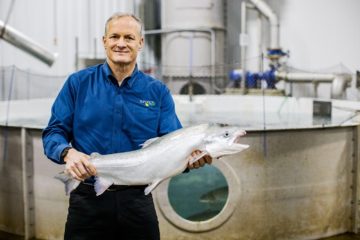Erik Stokstad in Science:
 NORTHFIELD, WISCONSIN—When drivers on Highway 94 pass this tiny town, some are struck by a mysterious nocturnal glow. Pink light emanates from the world’s largest aquaponic greenhouse, which can produce up to 2 million kilograms of salad greens each year. Less obvious, but also unique at this scale, is the source of the nutrients used to fertilize the crops: wastewater flowing from huge nearby tanks teeming with Atlantic salmon. The silvery fish grow indoors, far from the ocean where wild salmon normally spend the bulk of their lives.
NORTHFIELD, WISCONSIN—When drivers on Highway 94 pass this tiny town, some are struck by a mysterious nocturnal glow. Pink light emanates from the world’s largest aquaponic greenhouse, which can produce up to 2 million kilograms of salad greens each year. Less obvious, but also unique at this scale, is the source of the nutrients used to fertilize the crops: wastewater flowing from huge nearby tanks teeming with Atlantic salmon. The silvery fish grow indoors, far from the ocean where wild salmon normally spend the bulk of their lives.
On a recent winter day, the surrounding farmland blanketed in snow, Steve Summerfelt opened the door to the fish house. Hundreds of meter-long fish swam vigorously in each house-size tank, while an overhead crane delivered a 1-ton sack of feed into an automated dispenser. Rumbling pumps and tanks filled with sand, separated from the fish tanks by a soundproof wall, treated wastewater that had been stripped of fish poop. Nitrogen and phosphorus were diverted to the vast greenhouse while cleansed water recirculated to the salmon. “Sometimes the water is so clean it looks like the fish are swimming in air,” says Summerfelt, an engineer who is head of R&D at the company, called Superior Fresh.
More here.
